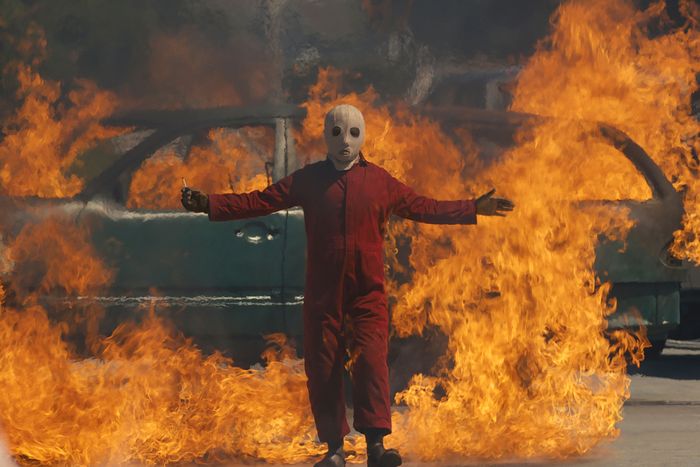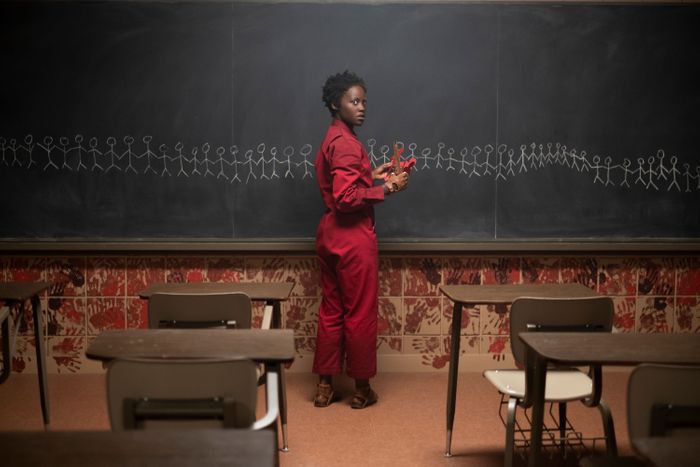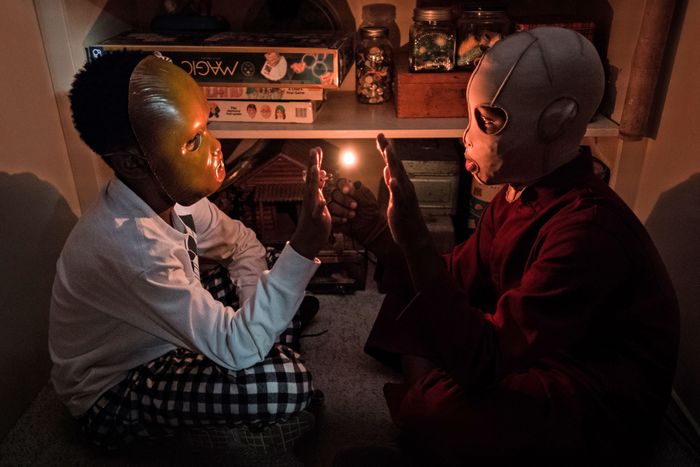
On the evening of Tuesday, March 19, two days before the opening of Jordan Peele’s critically acclaimed Get Out follow-up Us, Twitter user @MaxCorn paired up and tweeted out an arresting pair of photographs:
The sartorial similarity was particularly striking because multiple reviews from the film’s SXSW premiere noted its copious visual references to The Shining, a debt that Peele himself seemed to acknowledge by quote-tweeting the photo pairing the next day, and adding the film’s notorious phrase “All work and no play … ”
But the parallels between Us and The Shining aren’t just a matter of homage, or clever promotional cosplay. The Shining is one of the most meticulously analyzed motion pictures of our time, a film that has been so widely broken down and puzzled-out that it beget a documentary of warring and complementary Shining fan theories, Room 237. In that film, every tiny detail — from a Calumet Baking Powder tin to a German typewriter to an oddly arranged skiing poster — is ripe for multiple interpretations, we’re told, because Stanley Kubrick was so fastidious that even things which looked like errors must be intentional and purposeful.
Jordan Peele has admitted to the same kind of micromanagement, announcing in promotional interviews, “Everything in this movie was deliberate, that is one thing I can guarantee you.” And so, even the throwaway minutiae of Us warrants pause, deliberation, and some attempt at analysis. Here’s a brief inventory, compiled from two viewings, of the film’s cultural references, roughly organized by their first appearance in the film.
The Tapes
The opening frames of Us will prompt immediate squinting and puzzling from eagle-eyed viewers, as the film begins with the image of a television surrounded by VHS tapes. Some of them are home recordings that are not legible to the naked eye in a theatre auditorium — we’ll have to return to those when the movie hits video — but the store-bought tapes are telling indeed:
C.H.U.D.: This 1984 sci-fi/horror hybrid concerns an outbreak of deaths and disappearances in New York City, caused by “undergrounders,” a race of mutants living in the city’s sewers. Late in Us, when the Wilsons are watching the first television news reports, a witness remarks, “Someone said they were coming from the sewers.” (In an interview with Polygon, Peele also admits a “little personal thing”: “My first girlfriend’s father directed C.H.U.D.”)
The Goonies: Another story of adventure in underground tunnels and shafts, but one quoted more explicitly in Us: At the end of Red’s big explainer speech in the underground classroom, she paraphrases Sean Astin’s big rallying-the-troops speech by telling Adelaide, “It’s our time now. Our time, up there.”
The Man With Two Brains: This 1983 Steve Martin comedy concerns a scientist who falls in love with a talking brain; Peele confirmed its “thematic connection” to Uproxx: “The idea of two intelligences sharing a soul in a way. And was probably a little reference to Get Out in there too.”
A Nightmare on Elm Street: In addition to another promo-tour clothing shout-out (again acknowledged by Mr. Peele), there are multiple references to Wes Craven’s 1984 horror classic, most notably: the burns on Pluto’s face, uncomfortably similar to Freddy Krueger’s; he and his family’s donning of a single, brown glove; and Adelaide’s trip through a boiler room, just like the one where Freddy took his victims.
The Right Stuff: Okay, on this one, your guess is as good as mine.
Hands Across America
On that television surrounded by tapes is a promo for the 1986 benefit event, and you’ll find more background on that here. (Gabe is right, come to find out; it would take “a shit load of coordination.”)
Michael Jackson
During her fateful birthday trip to the Santa Cruz Beach boardwalk, little Adelaide covers up her Hands Across America T-shirt with her prize: a shirt for Michael Jackson’s Thriller. (“That shirt better not give her nightmares,” her mother warns her father.) Jackson wore a red jacket and pants in that album’s title video, and his single glove became his most iconic accessory in that period; that costume is echoed in the “Tethered” uniform of red coveralls and a single glove. (The coveralls also recall one of the best villains in horror cinema, Halloween’s Michael Myers.) And finally, it’s worth noting that in the timeframe of this 1986 prologue, Jackson would have been recording his follow-up album, Bad, featuring a ballad called … “The Man in the Mirror.”
The Lost Boys
“They’re filming something by the carousel,” Adelaide’s mother tells her father, as they stroll the boardwalk. “You should see if they’re looking for extras.” Joel Schumacher’s teen vampire hit The Lost Boys shot on the Santa Cruz Beach Boardwalk in 1986; Peele confirmed the connection to Uproxx.
Big
Adelaide’s mother also tells her father that their daughter is “not big enough” to ride the Big Dipper roller coaster. It’s a moment that echoes the inciting action of Penny Marshall’s Big, in which a carnival trip changes a life, creating two versions of the same person.
Jeremiah 11:11
On her way down the steps to the trauma that will change her life, Adelaide passes a homeless man holding a cardboard sign that reads “Jeremiah 11:11.” That verse, according to the King James version, goes like this: “Therefore thus saith the Lord, Behold, I will bring evil upon them, which they shall not be able to escape; and though they shall cry unto me, I will not hearken unto them.” It foreshadows the uprising of “The Tethers” later in the movie.
But Us is replete with 11s. Adelaide’s Thriller shirt is prize number 11. Shortly before their doubles show up, Gabe settles in to watch a Giants game that’s tied 11-11 in the seventh inning. Jason points out that the time is 11:11 during his tender bedtime scene with his mother. And when the tethered version of the sign-carrying homeless man shows up at the end of the movie, he simply has four 1s gouged into his forehead — underscoring that the verse is, above everything else, four 1s in a row, as seen in the film’s most haunting promo image.
Black Flag
In Us’s 1986, a Whac-A-Mole guy wears a Black Flag t-shirt — black print on white fabric. In 2019, one of the Tyler family twins also wears a Black Flag t-shirt — white print on black fabric, the earlier shirt’s mirror (okay, photo-negative) image.
Jaws
One of the easier references to spot, since Jason is first seen wearing a Jaws logo tee. But there are two other visual references in Us to Steven Spielberg’s blockbuster. That film opens with a late night beach scene, similar to the beach prelude of Adelaide’s trip into the house of mirrors (complete with a bonfire burning in the background); she goes inland instead of out to sea to find her terror. And when the Wilson family goes to the beach later in the film, adult Adelaide gazes off, watching the various happenings on the beach, tuning out the jabbering of the person next to her — just as Roy Scheider’s Martin Brody does in Jaws. And finally, that character’s most memorable line, “We’re gonna need a bigger boat,” is echoed by Gabe’s proclamation, “Boats are done. I am done with boats!”
Something Wicked This Way Comes
Ray Bradbury’s terrifying novel, which was adapted into a feature film (by Disney, oddly) in 1983, concerns the arrival, in a small town, of a traveling carnival called Cooger & Dark’s Pandemonium Shadow Show — emphasis, for our purposes, on “shadow.” And just like in Us, one of the centerpieces of that carnival, and key set piece location for the book and film, is the “Mirror Maze.” (Also, Orson Welles’s The Lady From Shanghai concludes with an oft-quoted sequence set in a “Magic Mirror Maze.”)
Rabbits
In her first explanation of the differences between the Tethered and Untethered, Red tells Adelaide that they have to eat “rabbit, raw and bloody.” Thus there are rabbits all over Us, and not just the ones scampering around in the climax. Adelaide’s daughter, Zora, is first seen in a T-shirt with a rabbit design, and her pajama sweatshirt is emblazoned with one word, “Thỏ” — Vietnamese for “rabbit.” And when Peele captures the rabbits in their cages ready to be eaten during the opening credits, he lingers long enough for us to note that the cages are arranged in rows of eleven.
The Shining
Aside from overall similarities in style and tone, Peele references Stanley Kubrick’s adaptation of Stephen King’s novel by replicating its looping overhead helicopter shots of the family car driving a mostly-empty road (both near the beginning and at the end of Us). He also uses, for both comic and sinister effect, a pair of identical twin girls. And both The Shining’s Wendy and Us’s Gabe attempt to use a baseball bat as a makeshift weapon, with little success.
Board Games
Among the board games in the closet of the summer house, aside from innocuous titles like Candyland and Drop It, are Monster Trap, in which monsters invade a home, and Guess Who?, in which players have to match up faces.
Scissors
The weapon of choice for the Tethered is scissors, the “sharp toys” they are given in lieu of Christmas gifts. “There’s a duality to scissors — a whole made up of two parts but also they lie in this territory between the mundane and the absolutely terrifying,” Peele told EW. And unsurprisingly, there are scores of horror and genre movies that use scissors as weapons, such as Hitchcock’s Dial M for Murder to Rabid, Schizoid, Oldboy, and Antichrist. But two in particular are noteworthy in relation to Us: Goodnight Mommy, in which a pair of terrorizing twins use a pair to cut open the superglue they’ve used to cover their mother’s mouth, and Dead Again, the Gothic noir with Kenneth Branagh and Emma Thompson each playing a pair of doubles.
I Spit on Your Grave
In Meir Zarchi’s notorious 1980 exploitation film, four invaders attack an urban woman in her country home; in retribution, one is later killed with a boat’s outboard motor. Abe, one of Us’s four home invaders, meets with the same grisly fate.
A Clockwork Orange
With all the attention paid to The Shining, it’s easy to miss the allusion to Kubrick’s earlier film. But both Us and Orange feature a sequence in which a crisp, clean, upper-class dwelling is invaded by attackers to incongruent music (“Singin’ in the Rain” in Orange, “Good Vibrations,” and “Fuck Tha Police” in Us).
Funny Games
Another disturbing home invasion story, this one from director Michael Haneke (who made the film twice, in 1997 and 2007), is referenced directly when Zora takes out several of the “Tethered” versions of the Tyler family with the chief weapon of Funny Games’ villains: a golf club.
De Palma
During the classroom scene between Adelaide and Red, Jordan uses a “split diopter” shot to show both of Lupita Nyong’o’s characters, in the same sharp focus, though they are on opposite sides of the room. The filmmaker most identified with this shot is Brian De Palma, whose breakthrough film was 1972’s Sisters — the story of a seemingly normal young woman and her murderous, evil twin.
The Twilight Zone
Peele’s affection for Rod Serling’s 1959-1964 sci-fi anthology series is well-known — he’s executive producer and host of its upcoming revival — and he has pinpointed the first season episode “Mirror Image” as a specific influence on Us. In it, a woman (Vera Miles) becomes convinced that she’s being followed by her own doppelgänger, and offers up a theory, based on “something I read or heard about a long time ago. About different planes of existence, about two parallel worlds that exists side by side, and each of us has a counterpart in this world. And sometimes, through some freak and through something unexplainable, this counterpart, after the two worlds converge, comes into our world. And in order to survive, it has to take over … Replace us. Move us out so that it can live. I remember reading it somewhere. Each of us has a twin in this other world, an identical twin.”
Spend too much time going down the rabbit hole of Us references, and you can drive yourself a little nuts. After all, these could just be some of those “crazy coincidences” that Elisabeth Moss’s Kitty Tyler mentions. But just to be safe, I should probably go watch The Right Stuff again. Maybe I’m just missing something.




